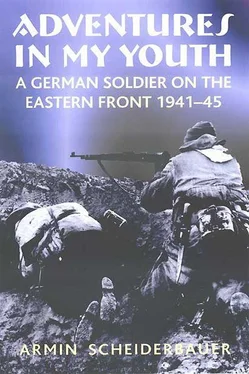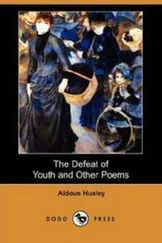There followed a few days of complete quiet. In order to keep our forthcoming attack as secret as possible, no exercises of any kind were staged. The men tried to catch up on the sleep they had lost in the summer. They lay on their backs for days on end and when it was dark visited the front-line cinema that had been established in a neighbouring village. Wien 1910 was showing there and it would have interested me because of the young Otto Wilhelm Fischer whom I liked very much. But I remained in my quarters in order to get a little peace and quiet. I was afraid too that I would be seized by homesickness for Vienna. But what I once more thoroughly enjoyed again in those days was riding. It was one last opportunity for it and only then was my life as a cavalryman to come to an end.
On the other hand, I denied myself another kind of pleasure. My batman Walter, always very concerned about my physical welfare, told me that Marja, a pretty and buxom washerwoman from the staff baggage-train, had fallen for me, and he offered to arrange a rendezvous. He could not understand and was almost hurt when I told him that I was not interested in anything like that. The fact that he had made the offer made further explanation seem superfluous.
On the night of 2 October the battalion was brought up to a point four kilometres behind the frontline. We were placed in houses that were still standing there. The order went out that, during the day, no movement must take place on account of enemy aerial reconnaissance. The attack was supposed to be a complete surprise. It was therefore impossible to take a walk. We could only leave the hovels to answer calls of nature.
In the afternoon came the regimental order for the next day. The Division had been given the task, together with the 3rd and 25th Panzer Divisions, of eliminating the bridgehead at Serock. After a concerted preparatory artillery barrage lasting 30 minutes, our Division was to move up between the two Panzer divisions. Within our Division it had been ordered that Regiment 461 would advance on the right, and Regiment 7 on the left, while Regiment 472 had to follow in the second wave. Most importantly, participating in the attack too were an assault gun brigade, two Nebelwerfer brigades, one heavy SS Panzerabteilung (Tiger), one Heeresartillerieabteilung , two mortar battalions and one flak regiment. The fact that we were to run up in reserve behind the two other regiments was almost a source of relief to me, since it showed me how highly General Meltzer valued the capability of the regiment and its commander. But it strengthened my resolve to return as soon as possible to my Regiment 7.
We spent the night of 3 October on straw in a hovel. We were lying pressed closely together, waking, dozing or sleeping. In the straw I found a small crucifix that I kept since it did not belong to anyone there. One of the people who had slept there before me or an inhabitant of the house must have lost it. I do not know what became of the crucifix. However, I lost it later when I was a prisoner. But there came to me the cheering promise of the in hoc signo , and I knew full well what victory that meant.
At 5am the half-hour heavy barrage began. We moved slowly forward between batteries of howling mortars and barking cannons. We had never before seen that kind of concentration of our own heavy weapons. We still had ammunition, we could still fire it, we could still attack and hopefully we could still gain the victory. Regiment 7 had already reached its target for the day at 10.30am. The attack had gone off smoothly and the enemy had fled. They had left behind few prisoners, but a lot of material. Oberleutnant Husenett and his company had taken an enemy mortar battery.
Half an hour after the attack began we had crossed the trenches. We looked with amazement at the American war matériel that had been left behind, from tinned meat to a motorcycle and sidecar and heavy Studebaker lorry. Some Russian trenches smelled of perfume. By this and by the articles of clothing that had been left behind, it could be seen that women, perhaps women soldiers, had been there. The Russians had not built bunkers, they simply had dugouts, each for two men, over which short thick tree trunks had been laid. They were an example of the admirable Russian capability of combining improvisation with the greatest usefulness. Since the entrances to these small bunkers opened, from our point of view, on the side facing the enemy, for myself I preferred to spend the night in a simple one-man foxhole without a roof. I remembered Major Brauer and Leutnant Buksch who had met their deaths a year before, at Nevel, in such a dugout that faced towards the enemy.
On 5 October, the second day of the attack, the Division was once more successful and Regiment 7 had reached the Narev at 2.30pm. We, in 472, moved up behind them as reserve and at the same time as spectators. The high ground facing the river was shelled by our mortars and artillery and then stormed. I was able to observe it through the field glasses. On the way I saw a human torso that had been torn apart by massive force. It was lying beside a destroyed SS Panzer reconnaissance vehicle, burnt out, a relic of the heavy fighting at the time that the bridgehead was being formed. From that sight even the hardened among us turned away in horror.
After the southern half of the bridgehead had been pushed back and was again in German hands, on 8 October the attack on the northern half was to take place. On 6 October we were moved 10 kilometres to the north, into a village that on the map looked like a star made up of roads. At the centre was a crossing from which seven roads or lanes stretched out exactly following the points of the compass. The only problem was that there was no road leading south-westward. As such, the crossing formed an ideal target for heavy weapons and was constantly under fire. In spite of that the cellars of the surrounding houses were fitted out with command posts from all possible units. The frontline was not a kilometre away towards the east.
As the orders had said, quite generally, that units should take over the command posts of the units to be relieved, Hauptmann Schneider had insisted on moving into the cellar at the crossing. He remained impervious to my suggestions for us to take up position in a cellar away from the crossing, especially since the cellar roof, only some 10 centimetres thick, did not provide adequate protection. The constant impact of shells very close by was gruelling even before the attack. In addition, runners and all who wanted to get to us were exposed to the most serious danger. When finally the leader of the signal section and two men had been wounded, I went on my own initiative to look for a suitable command post. I found it 300 metres along the road leading westwards, in a considerably deeper and better-covered cellar. Without Schneider’s approval, I asked the regiment whether we could move. It was approved and Hauptmann Schneider himself was afterwards pleased that we were away from the main impact area.
There were no good omens for the second part of the attack on the bridgeheads. With the rain, mist and badly softened ground it presented a very difficult task, to which situation the confused terrain was also a contributory factor. We had advanced only one kilometre. During previous days the Russians had laid many mines, so that numerous tanks drove over them and were lost. In addition the preparatory fire was weaker than it had been on 4 October and we had not succeeded in destroying the underwater nets over the Narev. As they had done in Stalingrad over the Volga, the Russians this time too laid nets under the surface of the water across the river, over which, with columns of carriers, they brought ammunition and above all mines.
Читать дальше












